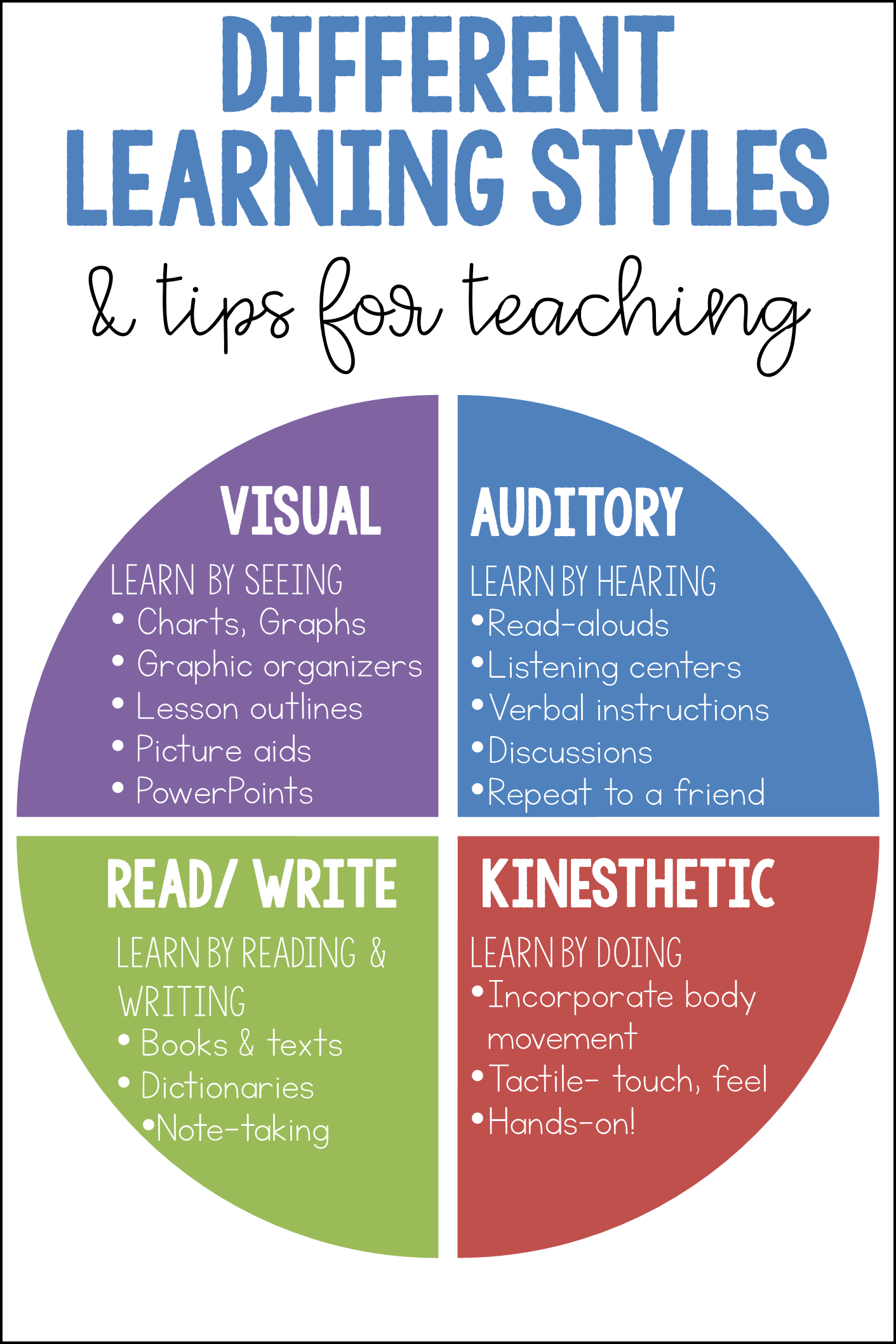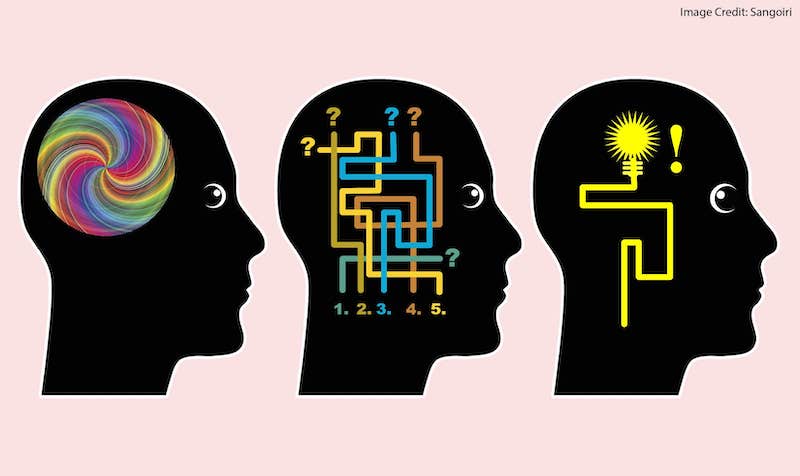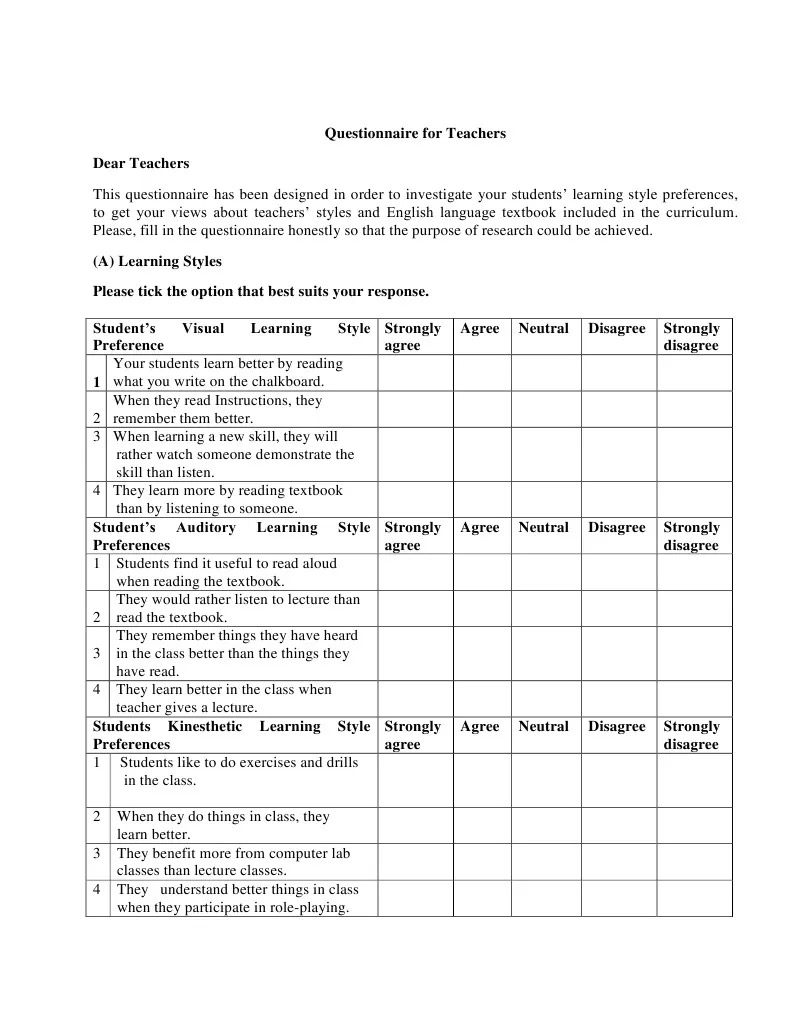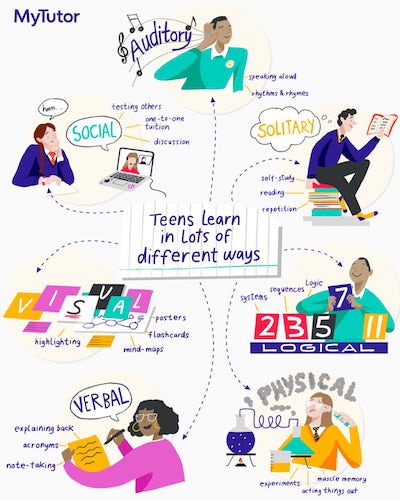Learning Styles
What are Learning Styles and are they still worth considering in the classroom?
Main, P (2022, November 15). Learning Styles. Retrieved from https://www.structural-learning.com/post/learning-styles
What are Learning Styles and are they still worth considering in the classroom?
Main, P (2022, November 15). Learning Styles. Retrieved from https://www.structural-learning.com/post/learning-styles
The idea of highlighting learning styles is that every student has a specific approach or style of learning. According to the learning theory, learning is more efficient or more effective if students are taught utilizing their preferred learning styles or approaches that have been specified as their learning style. For instance, students categorised as having a visual learning style could be instructed more effectively through pictures, charts and graphs while using traditional visual practices.
If you are studying towards an educational degree or psychology certificate, then you will probably come across this theory of Learning flexibility at some point. This article is not promoting this infamous theory as, in recent years, the lack of empirical evidence for styles of learning has been increasingly highlighted. During the early 2000's, it was not uncommon for schools to label children with their 'preferred learning style'. This type of poor practice meant that children were very quickly (and incorrectly) categorised. At best, this would have been detrimental to educational attainment, and the myth in some schools continues to this day.
For the purposes of this blog post, we will revisit the idea and provide you with some of the theoretical background, it will be up to you and your colleagues to decide whether there is any credibility in this classroom myth. We do know that using visuals within the context of dual coding is a powerful learning methodology. We also know that encouraging purposeful classroom talk (oracy) promotes educational outcomes.
The notion that we should be identifying 'a preferred learning style and using this to dictate our classroom practice, for most of us, is a little uncomfortable. However, if you are currently undertaking a research project or enrolled in an education degree, then you are probably going to come across this theory and it's worth knowing a little background to the concept.
While the latest research implies that matching instructional techniques to the learning styles model has no impact on learning outcomes, the theory of learning styles continues to be extremely popular.
Learning styles model are a well-known education and psychology concept and are meant to specify how individuals show retention of material and the best of their learning.
The idea behind the theory is that to effectively utilize learning styles, it's important to also consider study strategies that align with each style. For example, students with an auditory learning style may benefit from recording lectures or reading aloud, while those with a kinesthetic learning style may prefer hands-on activities and interactive learning experiences.
The concept implies to identify your own learning style through a Learning Style Inventory, which is a tool that assesses your preferred learning style. The inventory may include questions about your preferred study environment, how you process information, and what types of activities you enjoy.
Once you know your learning style, you can tailor your study strategies to better suit your individual needs and preferences. The theory being that this can lead to more effective learning and better retention of information.
Different teaching methods have been developed based on the theory of learning styles. For example, teachers can incorporate visual aids for visual learners, hands-on activities for kinesthetic learners, and discussions for auditory learners. By understanding the background and theory of learning styles, educators can better cater to the diverse needs of their students and create a more inclusive learning environment.
The VARK Model of Learning Styles
In 1987, Neil Fleming designed The VARK model of learning styles. According to The VARK model of learning styles, there are 4 basic styles of learning: auditory, visual, kinesthetic, and reading/writing.
Visual learners tend to learn the best through pictures and other forms of visuals. Teachers were encouraged to teach according to the students 'preferred Personal Preference' using graphic displays like diagrams, charts, videos, handouts, and illustrations.
It is because visual learners show retention of material through the learning process involving visual resources as visual learners would rather see knowledge provided in a visual form than in an auditory or written style.
Teachers may assess learner behavior or carry out Learning Style Assessment and identify a student as a visual learner if the student has the following Study Habits:
The most effective teaching and retention of material occur when teachers help visual learners by using an instructional method involving their Personal Preferences of learning style instruments such as flashcards and graphs while teaching new information.

Auditory learners (also called aural learners) tend to learn best through listening to information. Auditory learners demonstrate better learning through lectures or when things are told to them. Teachers may assess learner behavior or carry out Learning Style Assessment and check Study Habits of the learner. Most auditory learners :
For most effective learning outcomes and retention of material teachers of auditory learners use things like podcasts and audiobooks, as these will help them to learn a new topic.
A kinesthetic learner (also referred to as tactile learner) learns best by doing and touching. Hands-on activities are crucial for the learning of kinesthetic learners. Teachers may assess learner behavior or carry out Learning Style Assessments and check Study Habits of a student. Kinaesthetic Learners include the following characteristics:
For long-term retention of learning, teachers of Kinaesthetic Learners must use an Instructional method involving hands-on activities and practical. These are the most effective learning strategies that help student retention when a Kinesthetic Learner wants to learn something new.

Reading and writing learners also called verbal learners, tend to learn better when the information is displayed as text and words. Verbal learners or linguistic learners show the best verbal learning when taught using words and language. Teachers may observe learner behavior or carry out Learning Style Assessment and identify Reading and Writing Learners as they tend to have the following features:
For most effective learning outcomes and long-Term retention verbal learning teachers may find it beneficial to use an instructional method of writing down learning material to help student retention and Reading and Writing Learners understand and remember it.

In 1984, one of the well-known Educational Psychologists named David Kolb proposed his Student Learning Styles Theory. Learning Style Theory or experiential learning cycle by Kolb AY is considered one of the most widely used theories of learning styles.
According to Kolb's learning style theory and experiential learning cycle every individual's study time preference emerges from life experiences genetics, and the needs of the current environment. Alongside describing four different learning styles in his Student Learning Styles Theory and experiential learning cycle, Kolb also developed a learning style inventory as well as, experiential learning theory.
The Learning Styles Theory by one of the well-known Educational Psychologists Kolb DA depend upon two Learning Style Preferences i.e. reflective/active and concrete/abstract.
David Kolb believed that individuals with Convergence Experiential Learning Styles possess dominant proficiency in the areas of Active Experimentation and Abstract Conceptualization. According to experiential learning cycle theory, they are highly capable of practical application for ideas. Kolb states that the convergent learners are more likely to show better student retention of learning where there is just one best answer or solution to a problem.
Kolb believed that the primary strengths of divergers are in the areas of Reflective Observation and Concrete Experience, which are practically the opposite characteristics of the Converger. Those with Divergent Experiential Learning Styles are good at arranging smaller pieces of information into a significant whole and watching the "big picture"
David Kolb states that Assimilators are proficient in the areas of Reflective Observation and Abstract Conceptualization. They tend to show more interest in abstract ideas rather than in humans, but they are not much concerned about theories' practical applications.
Kolb AY states that people with this learning method are scientific and mathematical learners as they most likely to work in areas of the basic sciences and mathematics. Kolb DA mentioned that people with these Learning Styles approaches tend to be more interested in planning and research work.
Out of all categories of learning styles, Accommodators tend to be the biggest risk-takers. A. Kolb states that they are the best at thinking on their own and modifying plans spontaneously according to new information.
While solving problems, accommodators most preferred Source Of Learning would be a trial-and-error technique. Those with these Student Learning Styles mostly work in IT fields or action-oriented careers like sales and marketing.
The theory of learning styles proposes that individuals have unique ways of learning and processing information, which can be classified into different "styles." However, this widely accepted theory has faced criticism due to the lack of empirical evidence supporting it. Despite decades of research, studies have failed to demonstrate that instruction is more effective when it is tailored to a student's learning style.
Critics of the theory argue that styles-based instruction may even be detrimental, as it can limit a student's exposure to new ideas and approaches by reinforcing their dominant learning style. Additionally, it raises concerns about teacher training and the practicality of implementing such instruction in diverse learning environments.
Several critical comments suggest that the learning style assessment may not be accurate as it relies heavily on self-reporting, and it is not always reliable or objective. Moreover, it is difficult to define and operationalize learning styles, making it hard to reach a consensus on how to measure them.
Overall, empirical evidence supports the idea that students learn in diverse ways, but the theory of learning styles does not provide a framework for developing effective instruction. Instead, educators should focus on creating a dynamic learning environment that allows all students to engage and learn in ways that leverage their unique strengths and abilities.
Due to lack of empirical evidence the reliability of the VARK learning styles model and other cognitive psychologists of learning styles have been criticized and questioned extensively. Some opponents of A. Kolb and the concept of learning styles theory are not in favour of labelling pupils as being different Types Of Learners because labelling as a particular learning style may be a barrier to learning outcomes.
Some Cognitive Psychologists and opponents of Learning Style Instruments claim that there is limited evidence that supports the effectiveness of these study strategies. According to them, depending too heavily on specific study strategies may result in problems for pupils as they may refuse to avail other Learning Style Approaches beyond their preferred learning styles or comfort zone.
Despite such criticisms, both VARK's study strategies and Kolb's Experiential Learning Theory and learning style approaches are popular among educators and students. Learners may feel attracted towards their individual Learning Styles. Some may find that their preferred style is somewhere between the both, such as a student may find both auditory and visual Learning Style Instruments equally appealing.

Despite the lack of evidence for this theory, changing the modality of learning might have its benefits. For many children, being faced with a mountain of text to decode and make sense of can in itself be a learning barrier.
The art of teaching is a dynamic and evolving practice, one that requires a keen understanding of the diverse learning styles that students bring into the classroom. As educators, we must strive to create an environment that fosters learning proficiency, accommodating the needs of both individual learners and social learners.
This can be achieved by adopting a variety of teaching styles, each tailored to the unique needs of the students. Here are ten tips to help you embrace this diversity in your classroom:
By recognizing and catering to the diverse learning needs of your students, you can create a more inclusive and effective learning environment.
Citation: Pashler, H., McDaniel, M., Rohrer, D., & Bjork, R. (2008). Learning styles: Concepts and evidence. Psychological Science in the Public Interest, 9(3), 105-119.
The idea of highlighting learning styles is that every student has a specific approach or style of learning. According to the learning theory, learning is more efficient or more effective if students are taught utilizing their preferred learning styles or approaches that have been specified as their learning style. For instance, students categorised as having a visual learning style could be instructed more effectively through pictures, charts and graphs while using traditional visual practices.
If you are studying towards an educational degree or psychology certificate, then you will probably come across this theory of Learning flexibility at some point. This article is not promoting this infamous theory as, in recent years, the lack of empirical evidence for styles of learning has been increasingly highlighted. During the early 2000's, it was not uncommon for schools to label children with their 'preferred learning style'. This type of poor practice meant that children were very quickly (and incorrectly) categorised. At best, this would have been detrimental to educational attainment, and the myth in some schools continues to this day.
For the purposes of this blog post, we will revisit the idea and provide you with some of the theoretical background, it will be up to you and your colleagues to decide whether there is any credibility in this classroom myth. We do know that using visuals within the context of dual coding is a powerful learning methodology. We also know that encouraging purposeful classroom talk (oracy) promotes educational outcomes.
The notion that we should be identifying 'a preferred learning style and using this to dictate our classroom practice, for most of us, is a little uncomfortable. However, if you are currently undertaking a research project or enrolled in an education degree, then you are probably going to come across this theory and it's worth knowing a little background to the concept.
While the latest research implies that matching instructional techniques to the learning styles model has no impact on learning outcomes, the theory of learning styles continues to be extremely popular.
Learning styles model are a well-known education and psychology concept and are meant to specify how individuals show retention of material and the best of their learning.
The idea behind the theory is that to effectively utilize learning styles, it's important to also consider study strategies that align with each style. For example, students with an auditory learning style may benefit from recording lectures or reading aloud, while those with a kinesthetic learning style may prefer hands-on activities and interactive learning experiences.
The concept implies to identify your own learning style through a Learning Style Inventory, which is a tool that assesses your preferred learning style. The inventory may include questions about your preferred study environment, how you process information, and what types of activities you enjoy.
Once you know your learning style, you can tailor your study strategies to better suit your individual needs and preferences. The theory being that this can lead to more effective learning and better retention of information.
Different teaching methods have been developed based on the theory of learning styles. For example, teachers can incorporate visual aids for visual learners, hands-on activities for kinesthetic learners, and discussions for auditory learners. By understanding the background and theory of learning styles, educators can better cater to the diverse needs of their students and create a more inclusive learning environment.
The VARK Model of Learning Styles
In 1987, Neil Fleming designed The VARK model of learning styles. According to The VARK model of learning styles, there are 4 basic styles of learning: auditory, visual, kinesthetic, and reading/writing.
Visual learners tend to learn the best through pictures and other forms of visuals. Teachers were encouraged to teach according to the students 'preferred Personal Preference' using graphic displays like diagrams, charts, videos, handouts, and illustrations.
It is because visual learners show retention of material through the learning process involving visual resources as visual learners would rather see knowledge provided in a visual form than in an auditory or written style.
Teachers may assess learner behavior or carry out Learning Style Assessment and identify a student as a visual learner if the student has the following Study Habits:
The most effective teaching and retention of material occur when teachers help visual learners by using an instructional method involving their Personal Preferences of learning style instruments such as flashcards and graphs while teaching new information.

Auditory learners (also called aural learners) tend to learn best through listening to information. Auditory learners demonstrate better learning through lectures or when things are told to them. Teachers may assess learner behavior or carry out Learning Style Assessment and check Study Habits of the learner. Most auditory learners :
For most effective learning outcomes and retention of material teachers of auditory learners use things like podcasts and audiobooks, as these will help them to learn a new topic.
A kinesthetic learner (also referred to as tactile learner) learns best by doing and touching. Hands-on activities are crucial for the learning of kinesthetic learners. Teachers may assess learner behavior or carry out Learning Style Assessments and check Study Habits of a student. Kinaesthetic Learners include the following characteristics:
For long-term retention of learning, teachers of Kinaesthetic Learners must use an Instructional method involving hands-on activities and practical. These are the most effective learning strategies that help student retention when a Kinesthetic Learner wants to learn something new.

Reading and writing learners also called verbal learners, tend to learn better when the information is displayed as text and words. Verbal learners or linguistic learners show the best verbal learning when taught using words and language. Teachers may observe learner behavior or carry out Learning Style Assessment and identify Reading and Writing Learners as they tend to have the following features:
For most effective learning outcomes and long-Term retention verbal learning teachers may find it beneficial to use an instructional method of writing down learning material to help student retention and Reading and Writing Learners understand and remember it.

In 1984, one of the well-known Educational Psychologists named David Kolb proposed his Student Learning Styles Theory. Learning Style Theory or experiential learning cycle by Kolb AY is considered one of the most widely used theories of learning styles.
According to Kolb's learning style theory and experiential learning cycle every individual's study time preference emerges from life experiences genetics, and the needs of the current environment. Alongside describing four different learning styles in his Student Learning Styles Theory and experiential learning cycle, Kolb also developed a learning style inventory as well as, experiential learning theory.
The Learning Styles Theory by one of the well-known Educational Psychologists Kolb DA depend upon two Learning Style Preferences i.e. reflective/active and concrete/abstract.
David Kolb believed that individuals with Convergence Experiential Learning Styles possess dominant proficiency in the areas of Active Experimentation and Abstract Conceptualization. According to experiential learning cycle theory, they are highly capable of practical application for ideas. Kolb states that the convergent learners are more likely to show better student retention of learning where there is just one best answer or solution to a problem.
Kolb believed that the primary strengths of divergers are in the areas of Reflective Observation and Concrete Experience, which are practically the opposite characteristics of the Converger. Those with Divergent Experiential Learning Styles are good at arranging smaller pieces of information into a significant whole and watching the "big picture"
David Kolb states that Assimilators are proficient in the areas of Reflective Observation and Abstract Conceptualization. They tend to show more interest in abstract ideas rather than in humans, but they are not much concerned about theories' practical applications.
Kolb AY states that people with this learning method are scientific and mathematical learners as they most likely to work in areas of the basic sciences and mathematics. Kolb DA mentioned that people with these Learning Styles approaches tend to be more interested in planning and research work.
Out of all categories of learning styles, Accommodators tend to be the biggest risk-takers. A. Kolb states that they are the best at thinking on their own and modifying plans spontaneously according to new information.
While solving problems, accommodators most preferred Source Of Learning would be a trial-and-error technique. Those with these Student Learning Styles mostly work in IT fields or action-oriented careers like sales and marketing.
The theory of learning styles proposes that individuals have unique ways of learning and processing information, which can be classified into different "styles." However, this widely accepted theory has faced criticism due to the lack of empirical evidence supporting it. Despite decades of research, studies have failed to demonstrate that instruction is more effective when it is tailored to a student's learning style.
Critics of the theory argue that styles-based instruction may even be detrimental, as it can limit a student's exposure to new ideas and approaches by reinforcing their dominant learning style. Additionally, it raises concerns about teacher training and the practicality of implementing such instruction in diverse learning environments.
Several critical comments suggest that the learning style assessment may not be accurate as it relies heavily on self-reporting, and it is not always reliable or objective. Moreover, it is difficult to define and operationalize learning styles, making it hard to reach a consensus on how to measure them.
Overall, empirical evidence supports the idea that students learn in diverse ways, but the theory of learning styles does not provide a framework for developing effective instruction. Instead, educators should focus on creating a dynamic learning environment that allows all students to engage and learn in ways that leverage their unique strengths and abilities.
Due to lack of empirical evidence the reliability of the VARK learning styles model and other cognitive psychologists of learning styles have been criticized and questioned extensively. Some opponents of A. Kolb and the concept of learning styles theory are not in favour of labelling pupils as being different Types Of Learners because labelling as a particular learning style may be a barrier to learning outcomes.
Some Cognitive Psychologists and opponents of Learning Style Instruments claim that there is limited evidence that supports the effectiveness of these study strategies. According to them, depending too heavily on specific study strategies may result in problems for pupils as they may refuse to avail other Learning Style Approaches beyond their preferred learning styles or comfort zone.
Despite such criticisms, both VARK's study strategies and Kolb's Experiential Learning Theory and learning style approaches are popular among educators and students. Learners may feel attracted towards their individual Learning Styles. Some may find that their preferred style is somewhere between the both, such as a student may find both auditory and visual Learning Style Instruments equally appealing.

Despite the lack of evidence for this theory, changing the modality of learning might have its benefits. For many children, being faced with a mountain of text to decode and make sense of can in itself be a learning barrier.
The art of teaching is a dynamic and evolving practice, one that requires a keen understanding of the diverse learning styles that students bring into the classroom. As educators, we must strive to create an environment that fosters learning proficiency, accommodating the needs of both individual learners and social learners.
This can be achieved by adopting a variety of teaching styles, each tailored to the unique needs of the students. Here are ten tips to help you embrace this diversity in your classroom:
By recognizing and catering to the diverse learning needs of your students, you can create a more inclusive and effective learning environment.
Citation: Pashler, H., McDaniel, M., Rohrer, D., & Bjork, R. (2008). Learning styles: Concepts and evidence. Psychological Science in the Public Interest, 9(3), 105-119.